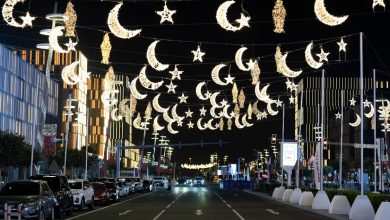
NU-Q opens first media museum in region
«نورثويسترن» تفتتح أول متحف إعلامي بالمنطقة
Doha: Located in the heart of one of the most advanced media and communication schools in the world, The Media Majlis at Northwestern University in Qatar, which is dedicated to the exploration of journalism, communication, and media in the Arab region has opened at Northwestern University’s campus in Doha.
The Media Majlis features a multi-screen façade, as well as space where exhibition content and technology converge. The technology elevates a visitor’s experience by inviting them to participate in a global conversation on a continually changing media landscape.
Drawing its name from the traditional Arab majlis—or gathering place—the museum seeks to be a vital source of interpersonal communication that connects values of local culture to universal and global concerns. All exhibitions are bilingual in English and Arabic, adding to the museum’s global essence and eliminating language barriers from telling the full story.
“The Media Majlis, a decade in the making, is a space where our students and faculty, as well as the general public, can engage with content that examines media influences and impact,” said Everette E. Dennis, dean and CEO at NU-Q. “The museum’s programming, which will explore everything from Arab representations in film, to censorship and identity, underscores the importance of media in society and draws on images and materials from local sources and global collections.”
The Media Majlis was officially dedicated by H H Sheikha Moza bint Nasser, chairperson of the Qatar Foundation, along with H E Sheikha Hind bint Hamad, vice-chairperson and CEO of the foundation; Morton Schapiro, president of Northwestern University; Jonathan Holloway, provost; and Dean Dennis.
A group of international media scholars and experts formed a Content Advisory Board that advised the university as it developed this unique museum where its exhibitions and programs are incorporated into the school’s curriculum and all exhibitions and programming is open to the public.
A member of the advisory board, Lisa Corrin, the director of the Block Museum of Art at Northwestern University in Evanston noted the connection between the mission of the Media Majlis and the academic program at NU-Q.
“The museum’s mission is to amplify the raison d’etre of Northwestern University – to be a portal through which young minds can learn to think critically about how the vast media landscapes shape our world and in turn how they can use these platforms to have influence in and beyond Qatar,” she said.
Exhibitions at the Media Majlis are curated so that visitors can journey through media-centric themes, exploring hundreds of images and films, as well as scores of original interviews – developed in-house – with scholars and professionals who are experts on the museum’s current exhibition topic.
The Media Majlis’s inaugural exhibition, Arab Identities, images in film, considers how over a century of film history has shaped and been shaped by notions of Arab identities. The exhibition, which features clips from more than 200 films ranging from the 1880s to the present day, is accompanied by loans posters, lobby cards and drawings from regional private collections in Kuwait and Beirut, as well as international, including a print from 1851 on loan from the Victoria and Albert Museum in London. The exhibition will be on view through December.
The Media Majlis is surrounded by academic resources and learning spaces. Located in the building that houses Northwestern’s campus in Qatar, it has access to a projection theatre for screening films, a black box for theatrical dramas, and a world-class fully-automated Newsroom, along with an auditorium that seats more than 100.
For the current exhibition, Arab Identities, images in film, programming includes exclusive film screenings with prominent filmmakers such as the director of the Academy Award nominated “Paradise Now,” Hany Abu Assad; Palestinian filmmaker Annemarie Jacir; and the Syrian directors and sisters Soudade Kaadan and Amira Kaadan.
أعلنت جامعة نورثويسترن في قطر، افتتاح أول متحف إعلامي صُمم خصيصاً لدراسة الصحافة والتواصل والإعلام في المنطقة العربية، ويضم المتحف المعروف باسم «مجلس الإعلام» الموجود بحرم الجامعة في الدوحة، واجهة متعددة الشاشات، بالإضافة إلى مساحة تجمع بين محتوى المعرض والتكنولوجيا، وتعمل هذه التقنية على إثراء تجربة الزوّار، من خلال دعوتهم للتفاعل مع المواضيع التي تربط الجمهور بالمشهد الإعلامي دائم التغيّر.
وقال إيفيرت دينيس عميد جامعة نورثويسترن في قطر ورئيسها التنفيذي: «إن مجلس الإعلام، مساحة يمكن من خلالها للطلاب وأعضاء هيئة التدريس وعامة الناس، التفاعل مع محتوى يدرس الوسائل الإعلامية وأثرها».
وتسلط برمجة المجلس «المتحف» -التي سوف تستكشف كل القضايا من التمثيل العربي في السينما، إلى الرقابة والهوية- الضوء على أهمية وسائل الإعلام في المجتمع، وتعتمد على الصور والمواد من المصادر المحلية والمجموعات العالمية.
وقد شكلت مجموعة من العلماء وخبراء الإعلام الدوليين هيئة استشارية للمحتوى، وقدمت المشورة للجامعة أثناء قيامها بتطوير هذا المتحف الفريد من نوعه، حيث تم دمج معارضها وبرامجها في المناهج الدراسية للجامعة، وجميع المعارض والبرامج مفتوحة للجمهور.
وأشارت عضو المجلس الاستشاري ليزا كورين مديرة متحف بلوك للفنون في جامعة نورثويسترن في إيفانستون، إلى العلاقة بين مهمة المجلس الإعلامي والبرنامج الأكاديمي في جامعة نورثويسترن في قطر.
وقالت: «تتمثل مهمة المتحف في تعزيز هدف الجامعة في أن تكون بوابة، يمكن من خلالها للعقول الشابة أن تتعلم التفكير بشكل نقدي، حول كيفية تشكيل وسائل الإعلام الواسعة لعالمنا، وبالتالي كيفية استخدام هذه المنصات لترك بصمة في قطر وخارجها».
ويعكس المعرض الافتتاحي لمجلس الإعلام، الهويات العربية، والصور في الأفلام، وكيف تشكل تاريخ الفيلم على مدى قرن من الزمان، وكيف شكلته مفاهيم الهوية العربية.
يرافق المعرض، الذي يحتوي على مقاطع من أكثر من 200 فيلم منذ عام 1880 إلى يومنا هذا، ملصقات قروض وبطاقات ردهة ورسومات من مجموعات إقليمية خاصة من الكويت وبيروت، وغيرها دولية، ومنها نسخة مطبوعة من عام 1851 عن قرض من متحف فيكتوريا وألبرت في لندن، وسيُقام المعرض خلال شهر ديسمبر.



